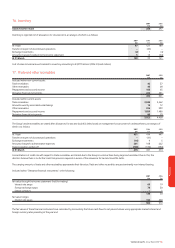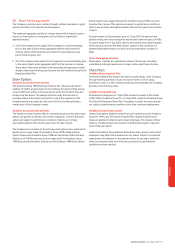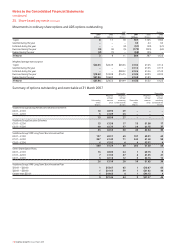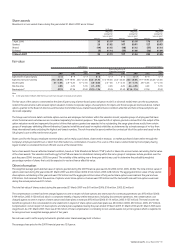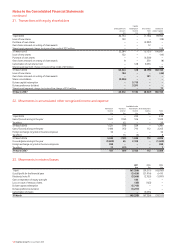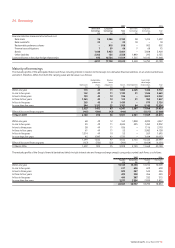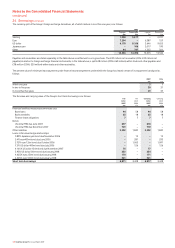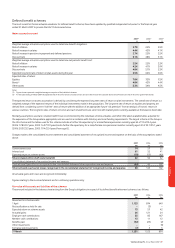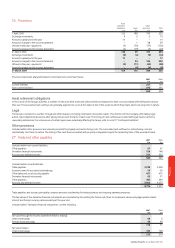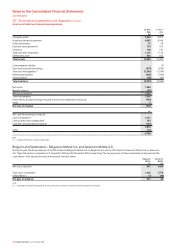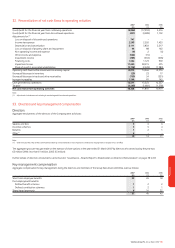Vodafone 2007 Annual Report Download - page 127
Download and view the complete annual report
Please find page 127 of the 2007 Vodafone annual report below. You can navigate through the pages in the report by either clicking on the pages listed below, or by using the keyword search tool below to find specific information within the annual report.
Vodafone Group Plc Annual Report 2007 125
Financials
Financial risk management
The Group’s treasury function provides a centralised service to the Group for
funding, foreign exchange, interest rate management and counterparty risk
management.
Treasury operations are conducted within a framework of policies and
guidelines authorised and reviewed annually by the Company’s Board of
directors, most recently on 25 September 2006. A Treasury Risk Committee,
comprising of the Group’s Chief Financial Officer, Group General Counsel and
Company Secretary, Group Treasurer and Director of Financial Reporting,
meets at least annually to review treasury activities and its members receive
management information relating to treasury activities on a quarterly basis.
In accordance with the Group treasury policy, a quorum for meetings is four
members and either the Chief Financial Officer or Group General Counsel and
Company Secretary must be present at each meeting. The Group accounting
function, which does not report to the Group Treasurer, provides regular
update reports of treasury activity to the Board of directors. The Group’s
internal auditors review the internal control environment regularly.
The Group uses a number of derivative instruments that are transacted, for
risk management purposes only, by specialist treasury personnel. There has
been no significant change during the financial year, or since the end of the
year, to the types of financial risks faced by the Group or the Group’s
approach to the management of those risks.
Capital management
The Group’s policy is to borrow centrally, using a mixture of long term and
short term capital market issues and borrowing facilities, to meet anticipated
funding requirements. These borrowings, together with cash generated from
operations, are on-lent or contributed as equity to certain subsidiaries. The
Board of directors has approved three debt protection ratios, being: net
interest to operating cash flow (plus dividends from associated undertakings);
retained cash flow (operating cash flow plus dividends from associated
undertakings less interest, tax, dividends to minorities and equity dividends)
to net debt; and operating cash flow (plus dividends from associated
undertakings) to net debt.
These internal ratios establish levels of debt that the Group should not
exceed other than for relatively short periods of time and are shared with
the Group’s debt rating agencies, being Moody’s, Fitch Ratings and Standard
& Poor’s.
Liquidity risk
As at 31 March 2007, the Group had $10.9 billion committed undrawn bank
facilities and $15 billion and £5 billion commercial paper programmes,
supported by the $10.9 billion committed bank facilities, available to manage
its liquidity. The Group uses commercial paper and bank facilities to manage
short term liquidity and manages long term liquidity by raising funds on
capital markets.
Market risk
Interest rate management
Under the Group’s interest rate management policy, interest rates on
monetary assets and liabilities denominated in euros, sterling and US dollars
are maintained on a floating rate basis, unless the forecast interest charge for
the next eighteen months is material in relation to forecast results, in which
case rates are fixed. Where assets and liabilities are denominated in other
currencies, interest rates may also be fixed. In addition, fixing is undertaken
for longer periods when interest rates are statistically low.
At 31 March 2007, 29% (2006: 29%) of the Group’s gross borrowings were
fixed for a period of at least one year. A one hundred basis point fall or rise
in market interest rates for all currencies in which the Group had
borrowings at 31 March 2007 would reduce or increase profit before tax by
approximately £24 million (2006: increase or reduce by £91 million),
including mark-to-market revaluations of interest rate and other derivatives
and the potential interest on outstanding tax issues. There would be no
material impact on equity.
Foreign exchange management
As Vodafone’s primary listing is on the London Stock Exchange, its share price is
quoted in sterling. Since the sterling share price represents the value of its
future multi-currency cash flows, principally in euro, sterling and US dollars, the
Group has a policy to hedge external foreign exchange risks on transactions
denominated in other currencies above certain de minimis levels. As the
Group’s future cash flows are increasingly likely to be derived from emerging
markets, it is likely that more debt in emerging market currencies will be drawn.
The Group also maintains the currency of debt and interest charges in
proportion to its expected future principal multi-currency cash flows. As such,
at 31 March 2007, 135% of net debt was denominated in currencies other than
sterling (107% euro, 20% US dollar and 8% other), whilst 35% of net debt had
been purchased forward in sterling in anticipation of sterling denominated
shareholder returns via dividends. This allows euro, US dollar and other debt to
be serviced in proportion to expected future cash flows and, therefore, provides
a partial hedge against income statement translation exposure, as interest
costs will be denominated in foreign currencies. Yen debt is used as a hedge
against the value of yen assets as the Group has minimal yen cash flows. A
relative strengthening in the value of sterling against certain currencies in
which the Group maintains cash and cash equivalents has resulted in a
decrease in cash and cash equivalents of £315 million from currency
translation differences.
The Group recognises foreign exchange movements in equity for the
translation of net investment hedging instruments and balances treated as
investments in foreign operations. However, there is no net impact on equity
for exchange rate movements as there would be an offset in the currency
translation of the foreign operation.
The following table details the Group’s sensitivity of the Group’s adjusted
operating profit to a strengthening of the Group’s major currencies in which it
transacts. Adjusted operating profit is defined as operating profit before non-
operating income of associated undertakings, impairment losses and other
income and expense. The percentage movement applied to each currency is
based on the average movements in the previous three reporting periods. The
analysis has been performed based on the movement occurring at the start of
the reporting period.
2007
£m
EUR 3% change
Adjusted operating profit 175
USD 8% change
Adjusted operating profit 176
Credit risk
The Group considers its maximum exposure to credit risk to be as follows:
2007 2006
£m £m
Bank deposits 827 948
Money market fund investments 5,525 1,841
Commercial paper investments 1,129 –
Derivative financial instruments 304 310
Trade receivables 2,886 2,499
10,671 5,598
The majority of the Group’s trade receivables are due for maturity within
90 days and largely comprise amounts receivable from consumers and
business customers.
Concentrations of credit risk with respect to trade receivables are limited due to
the Group’s customer base being large and unrelated. Due to this,
management believes there is no further credit risk provision required in excess
of the normal provision for bad and doubtful receivables (note 17).


